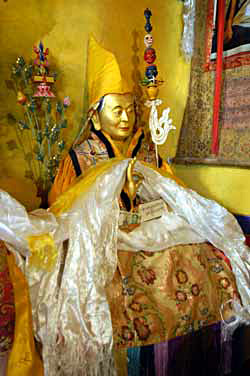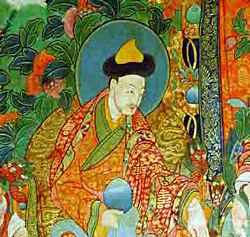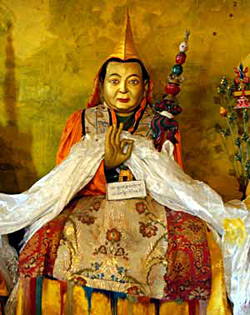History

Jetsün Lama Ngawang Namdröl, seen by the monks who live here as the founder of the monastery.
One contemporary Tibetan author states that according to oral tradition Trashi Chöling may date to the time of the Buddhist king (of Tibet) Songtsen Gampo (Chögyel Songtsen Gampo), that is, to the seventh century, being known at that time not under its present name, but rather as Dukyur Gön.7 The first real evidence we have of a monastic institution existing at the site, however, is much later. According to one contemporary Tibetan historian,8 Trashi Chöling is the place where the Mongolian ruler of Tibet, Lhazang Khan (Lhazang Khang), housed the monks of his private ritual college during the winter months. We know from different historical sources that Lhazang’s ritual college – the monks who were responsible for performing all of the necessary merit-making and protection rituals for the king – met in Northern Tibet (Jang) during the summer months, and then moved to a site just north of Lhasa for the winter. Trashi Chöling, it seems, was that site.
Shortly after Lhazang came to power in 1705, he came to an agreement with the monks of Sera. Seeing that the Sera Assembly Hall – the place where all of the monks gathered for communal rituals – was too small to fit the entire monastic population, he offered to build the community a new assembly hall. The monks, from their side, had to surrender the old assembly hall to the king, who proposed to use it as the permanent home for his private ritual college. An agreement was reached, and the king built what is today the Sera Great Assembly Hall. The old assembly hall then became the headquarters for the ruler’s ritual college. After the death of Lhazang in 1717, his ritual college became the Sera Tantric College,9 an institution that continues to flourish to the present day.

Lhazang Khan (Lhazang Khang), from a mural in the Sera Great Assembly Hall (Sera Tsokchen).
Although the monks of Lhazang’s ritual college moved to Sera permanently, it seems clear that they did not give up their rights to their old winter residence at Trashi Chöling in the mountains northwest of Sera. And when Lhazang’s ritual college became the Sera Tantric College, then, of course, ownership of Trashi Chöling passed on to the Sera Tantric College. For 200 years – from the early eighteenth century until the early twentieth century – we know little about Trashi Chöling except for the fact that it was (or so it seems) the property of the Sera Tantric College. Dungkar Rinpoché informs us that there was a tradition that the Sera Tantric College had to send twenty-one monks to Trashi Chöling to maintain the hermitage and to enact its ritual cycles, and this is certainly consistent with the facts as we know them.
In the early twentieth century, the Pabongkha Dechen Nyingpo did an extensive retreat in some caves close to Trashi Chöling at a site called Takten Druppuk. This established Pabongkhapa’s connection to this general area. Later, when Pabongkha Rinpoché’s fame and reputation grew, the Sera Tantric College offered the monastery of Trashi Chöling to him as his private hermitage or retreat.10 In return, Pabongkha Rinpoché agreed to officially enter the Tantric College (an action that brought this institution a certain prestige, given the lama’s reputation). From that point on, then, Pabongkha had two affiliations at Sera: the Tantric College, and the Mé College. Informants tell us that from then on Pabongkha Rinpoché lived at Trashi Chöling during the summer months, and in private rooms in a section of the Bombora Chikhang at Sera during the winter months.

A statue of Pabongkha Rinpoché in the main temple at Trashi Chöling.
Under Pabongkha Dechen Nyingpo the hermitage was extensively refurbished and expanded. It was perhaps under him as well that a very large temple to the protector deity Dorjé Shukden11 was built on the topmost tier of the complex. Today, as had been mentioned, this lies in ruins.
After the events of 1959 Trashi Chöling suffered the fate of all of Sera’s hermitages. Over thirty years of neglect brought the site to the brink of complete collapse. Restoration did not begin until a monk – a student of Pabongkha Dechen Nyingpo – undertook the labor of renovating the hermitage as a personal project in the early 1990s. The hermitage is maintained today by two elder monks who serve as temple attendants and caretakers of the site. They also receive help from the nuns of Takten Hermitage (Takten Ritrö), who live just up the hill.